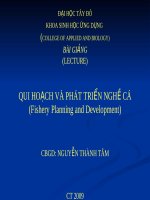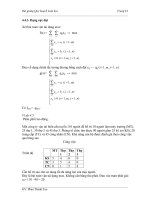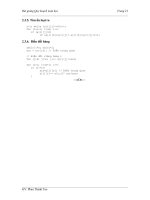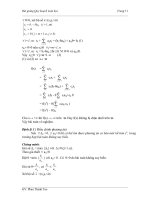bài giảng quy hoạch du lịch
Bạn đang xem bản rút gọn của tài liệu. Xem và tải ngay bản đầy đủ của tài liệu tại đây (11.11 MB, 80 trang )
1
11
BÀI GIẢNG BÀI GIẢNG
QUI HOẠCH DU LỊCHQUI HOẠCH DU LỊCH
22
Course outlineCourse outline
SubjectSubject Tourism PlanningTourism Planning
Units of creditUnits of credit 3 (45 periods)3 (45 periods)
PrerequisitePrerequisite Introduction to TourismIntroduction to Tourism
Suggested selfSuggested self studystudy 135 periods135 periods
InstructorsInstructors Võ Nguyễn Hồng LamVõ Nguyễn Hồng Lam
Contact detailContact detail @yahoo.ca
Cell phone: 01657277282Cell phone: 01657277282
2
33
Textbooks: Textbooks:
1. Clare A. Gunn, Turgut Var (2002), Tourism 1. Clare A. Gunn, Turgut Var (2002), Tourism
PlanningPlanning Basics, Concepts, Cases, Fourth Basics, Concepts, Cases, Fourth
Edition, Taylor and Francis Books Inc.Edition, Taylor and Francis Books Inc.
2. Edward Inskeep (1991), Tourism Planning 2. Edward Inskeep (1991), Tourism Planning ––
An integrated and sustainable development An integrated and sustainable development
approach, John Wiley & Sons Inc.approach, John Wiley & Sons Inc.
44
Subject objectivesSubject objectives:: The specific objectives of this subject are to The specific objectives of this subject are to
help students to:help students to:
Explain the tourism planning concept and the contemporary tourism Explain the tourism planning concept and the contemporary tourism
development trends;development trends;
Understand different approaches to tourism planning;Understand different approaches to tourism planning;
Describe site development standards and tourist facilities quality Describe site development standards and tourist facilities quality
standards; Establish carrying capacity;standards; Establish carrying capacity;
Explain regional tourism planning concepts and process Explain regional tourism planning concepts and process –– discovery discovery
of tourism potential, evaluation of attractions using survey of tourism potential, evaluation of attractions using survey
techniques.techniques.
Discuss planning and managing different types of attractions. Discuss planning and managing different types of attractions.
Explain resort planning approach and principles;Explain resort planning approach and principles;
Discuss urban tourism planning and planning for other forms of Discuss urban tourism planning and planning for other forms of
tourismtourism
Conduct survey and analysis on tourist markets, tourism facilities Conduct survey and analysis on tourist markets, tourism facilities
and infrastructures. and infrastructures.
3
Lecture 1Lecture 1
Tourism planning backgroundTourism planning background
ObjectivesObjectives
1.1. Understand the concepts of planning and Understand the concepts of planning and
plannerplanner
2.2. Describe goals for tourism developmentDescribe goals for tourism development
3.3. Describe differences between the 3 scales of Describe differences between the 3 scales of
tourism planning.tourism planning.
4
77
1. Planning and planners1. Planning and planners
Purposes of planning:Purposes of planning:
Dealing with the inappropriate use of tourism Dealing with the inappropriate use of tourism
resources.resources.
Creating plans of actions for a foreseeable future Creating plans of actions for a foreseeable future
and implementing it.and implementing it.
88
1. Planning and planners1. Planning and planners
“Plannning is a multidimentional activity that seeks to be “Plannning is a multidimentional activity that seeks to be
integrative. It embraces social, economic, political, integrative. It embraces social, economic, political,
psychological, anthropological and technological factors. It psychological, anthropological and technological factors. It
concerns with the past, present and future (Rose, 1984).concerns with the past, present and future (Rose, 1984).
5
99
1. Planning and planners1. Planning and planners
Difficulties:Difficulties:
Complexity of thousands of decisions made by Complexity of thousands of decisions made by
individuals, corporations and Governmentsindividuals, corporations and Governments
Planning places too much power in a Planning places too much power in a
governmental bureaucracygovernmental bureaucracy
So many plans collect dust on the shelfSo many plans collect dust on the shelf
Most tourism planning approaches have been Most tourism planning approaches have been
influenced by the field of urban and rural influenced by the field of urban and rural
planning.planning.
1010
Who are the plannersWho are the planners
The business sectorThe business sector
The public sectorThe public sector
The nonprofit sectorThe nonprofit sector
Professional consultantsProfessional consultants
6
1111
* The planners* The planners
Tourism business owners and managersTourism business owners and managers::
Search for the best destination and locationSearch for the best destination and location
Planning of products, services, quality levelPlanning of products, services, quality level
Planning of business promotion and selling.Planning of business promotion and selling.
1212
* The planners* The planners
Government:Government:
Spend money on destination marketing and Spend money on destination marketing and
promotionpromotion
Provide a great number of visitor attractionsProvide a great number of visitor attractions
Own and manage much of the infrastructures Own and manage much of the infrastructures
upon which tourism dependsupon which tourism depends
Set policies and regulations.Set policies and regulations.
7
1313
* The planners* The planners
NonNon profit sector:profit sector:
Support protection of natural and cultural Support protection of natural and cultural
resources for tourism developmentresources for tourism development
Saving and efficient use of operational resourcesSaving and efficient use of operational resources
Promotion of ethical practices.Promotion of ethical practices.
1414
* The planners* The planners
Professional consultants:Professional consultants:
Building architects Building architects –– hotels, resorts, restaurants, attractions, hotels, resorts, restaurants, attractions,
monuments, theatres, aquariums, etcmonuments, theatres, aquariums, etc
Landscape architects Landscape architects –– site and land planningsite and land planning
Urban planning Urban planning –– services, utilities, transport, land useservices, utilities, transport, land use
Civil engineers Civil engineers –– designs and details of bridges, harbors, designs and details of bridges, harbors,
airports, waste treatment facilitiesairports, waste treatment facilities
Teams of the specialistsTeams of the specialists provide the needed mix for provide the needed mix for
projectsprojects
8
1515
2. Goals for tourism development2. Goals for tourism development
Goals and objectives:Goals and objectives:
Objective: specific, real, actual activities, can be Objective: specific, real, actual activities, can be
accomplished within a given timeaccomplished within a given time
Goal: ideals or aims, can strive for but may never Goal: ideals or aims, can strive for but may never
completely accomplishcompletely accomplish
Goals provide the framework for the Goals provide the framework for the
identification of policies and accomplishment of identification of policies and accomplishment of
specific objectives.specific objectives.
1616
2. Goals for tourism development2. Goals for tourism development
The following goals are suggested for today’s The following goals are suggested for today’s
vision of better tourism development:vision of better tourism development:
Enhanced visitor satisfactionsEnhanced visitor satisfactions
Improved economy and business successImproved economy and business success
Sustainable resource useSustainable resource use
Community and area integration.Community and area integration.
9
1717
3. Tourism planning scales3. Tourism planning scales
Tourism planning is different in objectives and Tourism planning is different in objectives and
processes from the macro to the micro scaleprocesses from the macro to the micro scale
The most popular today is The most popular today is site scalesite scale
There are many opportunities for better tourism There are many opportunities for better tourism
success by planning at the success by planning at the scale of the destination scale of the destination
zonezone
Regional scaleRegional scale of planning is needed in order to of planning is needed in order to
determine greatest potential for a larger area.determine greatest potential for a larger area.
1818
3. Tourism planning scales3. Tourism planning scales
SiteSite project for tourism must include detailed project for tourism must include detailed
and current travel market information.and current travel market information.
Planners understand all factors of market Planners understand all factors of market
demand as well as location.demand as well as location.
Planning for every tourism facility and service Planning for every tourism facility and service
must encompass many relationships.must encompass many relationships.
10
1919
3. Tourism planning scales3. Tourism planning scales
DestinationDestination refers to the communityrefers to the community attraction attraction
complex. The basic elements of planning at the complex. The basic elements of planning at the
destination scale are:destination scale are:
Transportation and access from travel markets to Transportation and access from travel markets to
one or more communitiesone or more communities
One or more communities with adequate public One or more communities with adequate public
utilities and managementutilities and management
Attraction complexes (clusters) that meet market Attraction complexes (clusters) that meet market
needsneeds
Efficient and attractive transportation link Efficient and attractive transportation link
between cities and attractions.between cities and attractions.
2020
3. Tourism planning scales3. Tourism planning scales
Planning at Planning at regionalregional scale is even more scale is even more
comprehensive than at the site and destination comprehensive than at the site and destination
zone scaleszone scales
Many more resource areas are involvedMany more resource areas are involved
A greater number of political jurisdictions are A greater number of political jurisdictions are
includedincluded
The time periods of accomplishment are much The time periods of accomplishment are much
longerlonger
Better integration of the whole.Better integration of the whole.
11
2121
ConclusionsConclusions
Planning should encompass all travelPlanning should encompass all travel
Planning must predict a better future.Planning must predict a better future.
Both planning and plans are needed for tourism Both planning and plans are needed for tourism
today.today.
Economic development must not be an exclusive goal Economic development must not be an exclusive goal
for planning.for planning.
Planning must incorporate all 3 sectors of tourism.Planning must incorporate all 3 sectors of tourism.
Planning processes today are becoming much more Planning processes today are becoming much more
interactive.interactive.
Three scales of planning need integration.Three scales of planning need integration.
2222
Discussion topicsDiscussion topics
Work in groups to find answers to the below questions :Work in groups to find answers to the below questions :
Group 1: What role can national governments play in tourism Group 1: What role can national governments play in tourism
planning?planning?
Group 2: As compared to shortGroup 2: As compared to short range planning, why is longrange planning, why is long range range
planning so difficult?planning so difficult?
Group 3: Why should communties and local residents be involved Group 3: Why should communties and local residents be involved
in tourism planning? in tourism planning?
Group 4: What is the difference b/w plans and planning as applied Group 4: What is the difference b/w plans and planning as applied
to tourism development.to tourism development.
Group 5: What are the barriers to reaching planning goals other Group 5: What are the barriers to reaching planning goals other
than the economy, and how can they be overcome?than the economy, and how can they be overcome?
12
2323
Lecture 2Lecture 2
Tourism Planning Tourism Planning
ApproachApproach
2424
24
Objectives
1. Recognize approaches to tourism
planning
2. Discuss different levels and types of
tourism planning.
13
2525
25
1. Approach to tourism planning1. Approach to tourism planning
The incremental and flexible approach:The incremental and flexible approach:
A continuous process with adjustments, butA continuous process with adjustments, but
Maintaining the basic objectives and policies Maintaining the basic objectives and policies
of tourism development.of tourism development.
2626
26
1. Approach to tourism planning1. Approach to tourism planning
The systems approach:The systems approach:
Tourism is viewed as an interrelated systemTourism is viewed as an interrelated system
Utilizing system analysis techniques.Utilizing system analysis techniques.
14
2727
27
1. Approach to tourism planning1. Approach to tourism planning
The comprehensive and integrated approach:The comprehensive and integrated approach:
All aspects of tourism development are All aspects of tourism development are
analyzed and plannedanalyzed and planned
Tourism is integrated into the overall plan of Tourism is integrated into the overall plan of
the areathe area
2828
28
1. Approach to tourism planning1. Approach to tourism planning
Environmental and sustainable development Environmental and sustainable development
approach:approach:
Natural and cultural resources are not Natural and cultural resources are not
depleted, butdepleted, but
Maintained as viable resources on a Maintained as viable resources on a
permanent basis for continuous future use.permanent basis for continuous future use.
15
2929
29
1. Approach to tourism planning1. Approach to tourism planning
The community approach:The community approach:
Maximum involvement of the local community Maximum involvement of the local community
in planning and decision making process of in planning and decision making process of
tourismtourism
Maximum involvement of the local community Maximum involvement of the local community
in development and benefits of tourism.in development and benefits of tourism.
3030
30
1. Approach to tourism planning1. Approach to tourism planning
The implementable approach:The implementable approach:
Realistic policy, plan and recommendationsRealistic policy, plan and recommendations
Implementation techniquesImplementation techniques
16
3131
31
1.Continuous, Incremental – adjustments
made as needed
2.Systems Approach – interrelated system
3.Comprehensive Approach – integrated
into the overall plan
4.Environmental & Sustainable – no
depletion or degradation
5.Community Approach – maximum
involvement and ownership
6. Application of systematic Planning –
logical sequence
3232
32
2. Approach to tourism planning2. Approach to tourism planning
The basic planning process follows successive steps as The basic planning process follows successive steps as
below:below:
Study preparationStudy preparation
Determination of development goals and objectivesDetermination of development goals and objectives
SurveysSurveys
Analysis and synthesisAnalysis and synthesis
Plan formulationPlan formulation
Recommendations.Recommendations.
ImplementationImplementation
MonitoringMonitoring
17
3333
Considerations Considerations
Market lead approach Market lead approach
Market demands should not have adverse effects, Market demands should not have adverse effects,
environment or social environment or social
Short Term vs Long Term benefits Short Term vs Long Term benefits
Integration with minimum impact Integration with minimum impact
Marketing is SpecificMarketing is Specific
Economic Diversification Economic Diversification
33
3434
Terminology Terminology Pg 31 (Textbook 2)Pg 31 (Textbook 2)
Discuss in GroupsDiscuss in Groups
Objective Objective
Policy Policy
PlanPlan
StrategyStrategy
ConservationConservation
34
18
3535
Tourism and the environment Tourism and the environment
Pg 32 (Textbook 2)Pg 32 (Textbook 2)
35
3636
36
3. Levels and types of tourism planning3. Levels and types of tourism planning
INTERNATIONAL LEVELINTERNATIONAL LEVEL
Concerned mostly withConcerned mostly with
international transportation services, the flow and tour international transportation services, the flow and tour
programming of tourists among different countries,programming of tourists among different countries,
complementary development of major attraction features complementary development of major attraction features
and facilities in nearby countries,and facilities in nearby countries,
multimulti country marketing strategies and promotion country marketing strategies and promotion
programs.programs.
19
3737
37
3. Levels and types of tourism planning3. Levels and types of tourism planning
International level.International level.
A new rail link between Vietnam and Laos (US$450 A new rail link between Vietnam and Laos (US$450
million), part of a transmillion), part of a trans Asia railway systemAsia railway system
Thailand will finance and build a third bridge across Thailand will finance and build a third bridge across
the Mekong River (US$41 million)the Mekong River (US$41 million)
Laos Airlines flights between Luang Prabang and Laos Airlines flights between Luang Prabang and
KunmingKunming
An accessAn access controlled tollway from Hanoi to Lao controlled tollway from Hanoi to Lao
Cai, US$1.1billion loan by ADB. Cai, US$1.1billion loan by ADB.
3838
38
3. Levels and types of tourism planning3. Levels and types of tourism planning
National and regional planning.National and regional planning.
Tourism policyTourism policy
Physical structure plan and infrastructure considerationsPhysical structure plan and infrastructure considerations
The general amount, type and quality of accommodation The general amount, type and quality of accommodation
and other tourist facilities and services requiredand other tourist facilities and services required
The major tour routesThe major tour routes
Tourism organization structures, legislation and investment Tourism organization structures, legislation and investment
policiespolicies
Overall tourism marketing strategiesOverall tourism marketing strategies
Education and training programs.Education and training programs.
20
3939
39
3. National planning: 3. National planning:
Vietnam tourism master plan in 1995Vietnam tourism master plan in 1995
Maximizing tourism contributions to the national economy, Maximizing tourism contributions to the national economy,
preserving traditional culture and human values, and maintaining preserving traditional culture and human values, and maintaining
the sustainable ecologically environmentthe sustainable ecologically environment
Welcoming 3.5 mil. Welcoming 3.5 mil. –– 3.8 mil. international tourists arrivals by 3.8 mil. international tourists arrivals by
2000 and 9 mil. by 20102000 and 9 mil. by 2010
3 tourism regions: the North (cultural tourism, sightseeing, study 3 tourism regions: the North (cultural tourism, sightseeing, study
tour); the Northern Central (historical tour, coastal tourism, cave tour); the Northern Central (historical tour, coastal tourism, cave
and transit tours); and the Southern Central and the South (marine and transit tours); and the Southern Central and the South (marine
and mountainous convalescence, water and garden based tourism)and mountainous convalescence, water and garden based tourism)
Construction of 4 Construction of 4 –– 5 star hotels in Hanoi, HCMC and coastal cities 5 star hotels in Hanoi, HCMC and coastal cities
and encouragement of foreign investors or JVs.and encouragement of foreign investors or JVs.
4040
40
3. Levels and types of tourism planning3. Levels and types of tourism planning
Regional Planning.Regional Planning.
For one region of a country i.e. state or province, within the For one region of a country i.e. state or province, within the
national framework national framework
More SpecificMore Specific
Regional PolicyRegional Policy
Regional accessRegional access
Type and location or attractionsType and location or attractions
Amount of accommodation/attractions Amount of accommodation/attractions
Marketing StrategiesMarketing Strategies
Regional education & training programs Regional education & training programs
21
4141
41
3. Levels and types of tourism planning3. Levels and types of tourism planning
Development area land use planning.Development area land use planning.
More detailed level of planning indicates specific areas for More detailed level of planning indicates specific areas for
urban tourist facilities, resorts and attractions. These plans urban tourist facilities, resorts and attractions. These plans
include:include:
Prefeasibility and feasibility studiesPrefeasibility and feasibility studies
Environmental Impact AssessmentEnvironmental Impact Assessment
Staging of development or development programmingStaging of development or development programming
Organizational and financial means for effective Organizational and financial means for effective
implementationimplementation
Zoning regulations and specific architectural, landscaping Zoning regulations and specific architectural, landscaping
and engineering design standards.and engineering design standards.
4242
42
3. Levels and types of tourism planning3. Levels and types of tourism planning
Facility site planning and Facility designFacility site planning and Facility design
Site planning is very specific planning for individual Site planning is very specific planning for individual
buildings or complexes of buildings such as resorts, hotels, buildings or complexes of buildings such as resorts, hotels,
restaurants, attraction features, landscaping areas.restaurants, attraction features, landscaping areas.
Facility designs may be based on concepts and standards Facility designs may be based on concepts and standards
adopted at the more general level of planning (international adopted at the more general level of planning (international
standards).standards).
22
Lecture 3Lecture 3
Regional Planning ConceptsRegional Planning Concepts
1/ 23
4444
ObjectivesObjectives
1.1. Recognize regional development hierarchy.Recognize regional development hierarchy.
2.2. Understand basic regional tourism planning concepts.Understand basic regional tourism planning concepts.
3.3. Identify zones with tourism potential.Identify zones with tourism potential.
2/ 23
23
4545
1. Regional development hierarchy1. Regional development hierarchy
Tourism development dependence hierarchyTourism development dependence hierarchy
Regional tourism development
Physical and program development of attractions, service
facilities, transportation, promotion – information for tourists
Increased participation
Greater number of tourists and increased involvement in more activities
Heightened demand
Increase in both desire and ability to
travel and participate
Expanded supply
Expanded capacity of existing
physical plant, establishments
Expanded markets
Increased ability to travel
Improved image toward travel
Travel given high priority
Increased mobility
Lessened social constraint
Lessened government constraint
Mobility of friends and relatives
Proximity to attractions
Population increases
Resource development
Abundant natural resources
Abundant cultural resources
Viable service communities
Easy access
Ongoing tourism reputation
Favorable development image
Local acceptance of tourism
Favorable government control
Available land, mgt, labor and finance
Depends upon
Which depends upon
Which depends upon
4646
2. Basic regional tourism planning concepts2. Basic regional tourism planning concepts
Research on land characteristics for tourism development: Research on land characteristics for tourism development:
Geographic position:Geographic position:
Distance and time of accessDistance and time of access
Ease of access.Ease of access.
Car
access
Plane, ship
access
4/ 23
24
4747
2. Basic regional tourism planning concepts2. Basic regional tourism planning concepts
Research on land characteristics for tourism development: Research on land characteristics for tourism development:
Geographic content Geographic content –– internal resource characteristics:internal resource characteristics:
TopographyTopography
SoilSoil
Vegetative coverVegetative cover
Water surfaceWater surface
HistoryHistory
5/ 23
4848
2. Basic regional tourism planning concepts2. Basic regional tourism planning concepts
The planning units of a region:The planning units of a region:
Also called destination zones,Also called destination zones,
Community Community –– attraction complexes, attraction complexes,
Circulation corridors, Circulation corridors,
NonNon attraction surroundings.attraction surroundings.
6/ 23
25
4949
DESTINATION ZONE: services,
facilities, things to see and do
Non-attraction area
Potential travelers, tourists, recreationists
MARKETS
ACCESS
Entrance
CIRCULATION
CORRIDOR:
land, air, water
7/ 23
5050
Model of attraction
NUCLEUS:
the principal
attracting force
INVIOLATE BELT:
Essential setting
ZONE OF CLOSURE:
Outer area of influence
(must include a service
center or community)
8/ 23









